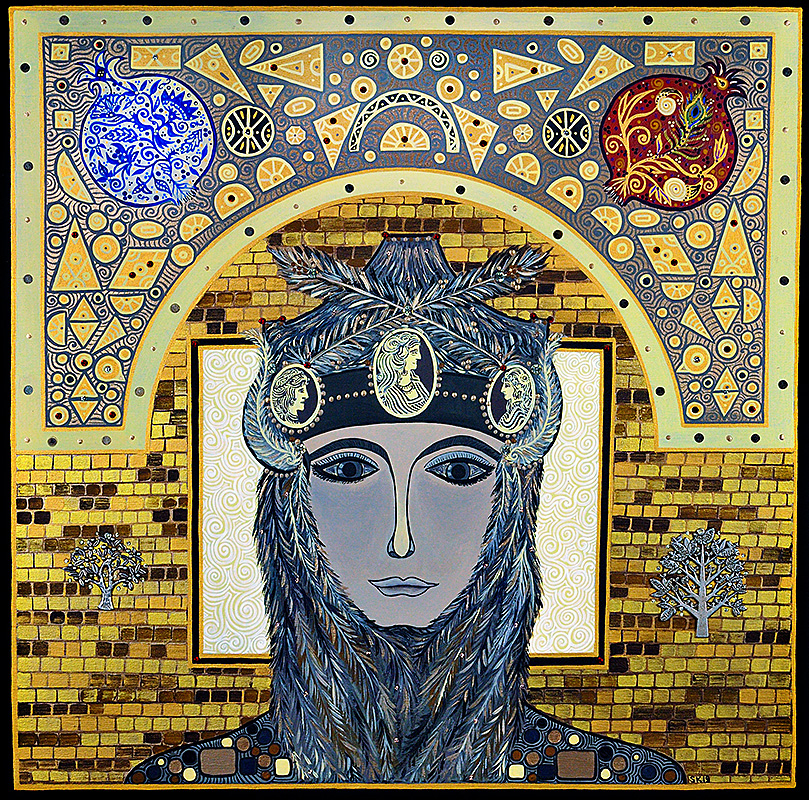- Year 2019
- Media Wooden panel, acrylic paint, golden, silver and bronze gilding paint, crystal elements
- Dimensions 50 x 50 cm
- Availability This painting is available for purchase. Price on request. Please don't hesitate to contact me.
- View more GALLERY
The Trigger Woman
“THE TRIGGER WOMAN” was inspired by the film “The Color of Pomegranates” made by the Soviet filmmaker Sergei Parajanov in 1968. It is also a part of the “De Personeae” (Personalities) cycle of paintings aiming to arrive at my own interpretation of images of personalities representing various cultures and symbolic ideas.
The film “The Color of Pomegranates” represents a series of “film paintings” (chapters or episodes) that recount the life of the 18th-century poet and troubadour, turned monk, also known as Sayat Nova, a Persian nickname that means “King of Songs”. These unusual film fragments create a structure of frames which encompass different snapshots filled with messages. It is a visual cryptic film with little to no dialogue where Sayat Nova’s poems are more seen rather than heard. The story is told much more in images than it is in words, reminding us of the time of silent film. A lot of the imagery in the film is taken from Sayat Nova’s works. It shows in a lot of detail the world which inspired him in his work: national architecture, folk art, nature, daily life, music, food, clothing, traditions, rituals, ornaments, and others. In terms of symbols and metaphors, this is indeed a unique film.
One of the images in the film that made a strong impression on me was that of a woman wearing a hat made of feathers, with almost ghostly like appearance, dressed in grayish coloured clothes. She appears briefly on a couple of occasions, usually at the cusp of two episodes, raising a gun to the air, pressing its trigger and firing it. As a result, someone else was hit in the film, wounded or died, although she did not directly aim at them. I took her image and interpreted it as the “Trigger Woman” – the one who “declares” that a change has come into effect in a string of situations or perhaps causes it (I wonder weather such a woman – harbinger – will appear in today’s world?…) I did not depict her pistol because it was not so important to me as an image as was the sound it produces. It is the one that causes the changing circumstances. Sound-symbols affect the viewer’s psyche as forcefully as image-symbols do.
The shooting sound of a gun is a symbol of suddenness and abruptness. It shatters the stillness and peacefulness which existed before it. It startles and scares. It alerts that change or death is coming. The result of the shooting is the glass broken into a myriad of pieces, flying in all directions, appearing in the upper part of the painting.
There are three episodes in the film in which three other women appear holding respectively white, red and black lace. They are not portrayed in the painting. Each color of the lace represents the three most important phases in life: the white lace is symbolic of birth, childhood, innocence and discovery; the red one – of adulthood, energy and love; and the black one – the withering, old age and end of life. In the midst of all these appears the “Trigger Woman”. From beginning to end, she ties them all together in a seemingly continuous thread. I plan to paint these too in the future.
There are a few other important symbols in the painting:
- the pomegranate – one of the most utilized symbols of Armenian tradition, associated with fertility, seduction and desire. Writers like William Saroyan, painters like Leon Tutundjian, and filmmakers like Atom Egoyan have all utilized it in their works as a safeguard of their cultural memory. The pomegranate appears also in the context of important celebrations or liminal (threshold) moments when someone passes from one stage of life to another: from childhood to adolescence to adulthood, journey, marriage, or funerals. However, Parajanov deconstructs the symbol of the pomegranate to also show the exact opposite meaning – destruction replaces creation, repulsion or grievance replace desire, death replaces fertility. Hence in my painting there is a blue pomegranate representing the dark side of life and a red one which carries the traditional meaning.
- the trees on both sides of the “Trigger Woman” symbolize growth, decay and resurrection.
In the end, I would like to make the provision that the “Trigger Woman” is my own interpretation of a very miniscule part of this extraordinary film. If Parajanov was alive today, perhaps he would not have accepted this interpretation, however, I believe that it points to a moment of the present day. If that is so, as an excuse, I will cite Parajanov’s own words which appear in one episodes of the film: “the world is a window.” We are all “looking intensely through our own windows” and seeing different images. We then interpret them and learn something new. This takes place daily. It is exactly this idea that underlies the creation of my painting.
